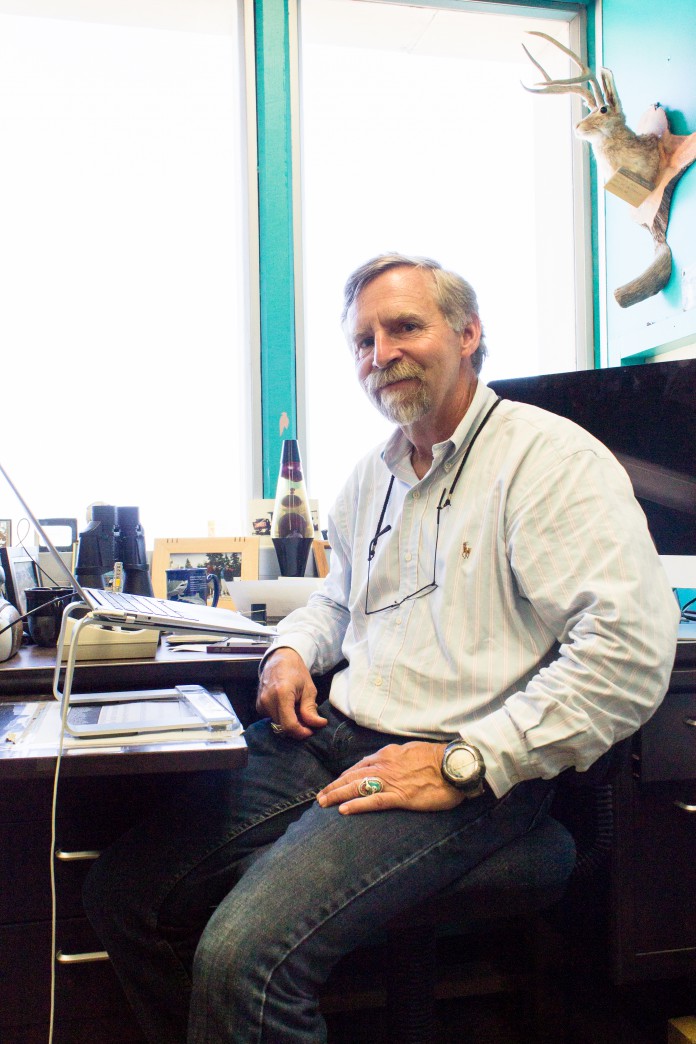Judy Lau
Staff Writer
Photo by Jinxuan Li
Dr. Dennis Clegg, a professor in the University of California, Santa Barbara’s Department of Molecular, Cellular, and Developmental Biology, plans on bringing stem-cell-based therapy for Age-related macular degeneration (AMD) to Phase I clinical trials.
Age-related macular degeneration (AMD) is the leading cause of vision loss in the United States for people ages 50 and older. Regenerative medicine based on stem cell research conducted by Clegg and co-researchers may one day cure people with AMD.
AMD comes in two forms: wet and dry. In wet form, for which treatment is available, growth of abnormal blood vessels causes blood and fluid to leak into the retina, causing vision distortion, blind spots, and loss of central vision.
“There has been prior research done on AMD and we were able to learn a lot from it,” said Clegg. “We are able to predict some of the symptoms, but there is no definite way to know whether someone has the disease until they actually get it.”
The dry form of the disease, however, does not have a treatment and is the primary focus of Clegg’s research. The dry form is caused by the presence of yellow deposits in the eye’s macula. As these deposits increase in count and size, vision is distorted. The light-sensitive layer of cells in the macular become thinner and eventually cause cell death, called retinal pigmented epithelium (RPE). These are the cells that are needed to allow light to be translated into recognizable images.
“It’s especially devastating because the visual defect occurs in the macula, which is the center of the retina,” Clegg explained. “That part is used for high acuity vision, so people with the disease end up with a big blank spot in the middle of their field of vision. Some reports estimate that more than 30 million people worldwide have this disease, so there is a real unmet medical need for a therapy.”
Clegg is co-director of the California Project to Cure Blindness, a collaborative effort aimed at developing a stem-cell-based therapy for AMD. The project’s goal is to develop a way to replace the dying RPE with new tissue created from embryonic stem cells.
“What we’re doing to combat the dry form of the disease is a completely different approach,” said Clegg. “We are using cellular therapy to treat the disease by putting a 3-by-5 millimeter contact-lens material coated with a layer of cells and implanting it surgically in the back of the eye where the RPE is.”
Caltech, one of the partners on the project, designed and built the scaffold that holds the cells. The material is permeable and flexible, but strong enough to withstand surgical implantation. Additionally, Mark Humayun, a professor of ophthalmology, cell and neurobiology, and biomedical engineering at the University of Southern California’s Keck School of Medicine devised a new tool that allows precise surgical implantation of the scaffold.
The research team conducted a variety of experiments over four years that demonstrated the cells’ ability to restore vision in a rat model of RPE dysfunction. CIRM funding is in place for the Phase I clinical trials, set to begin once the project receives Federal Drug Administration (FDA) approval. Once approved, the clinical trials will take place at USC.
“Making a drug that actually works takes years of clinical trials and has a high failure rate, but trying different methods and applications is a great way to conduct biomedical research and find new therapies,” said Clegg. “Although UCSB does not have a medical school, a great amount of biomedical research happens on campus that may one day benefit people with all kinds of eye diseases.”











